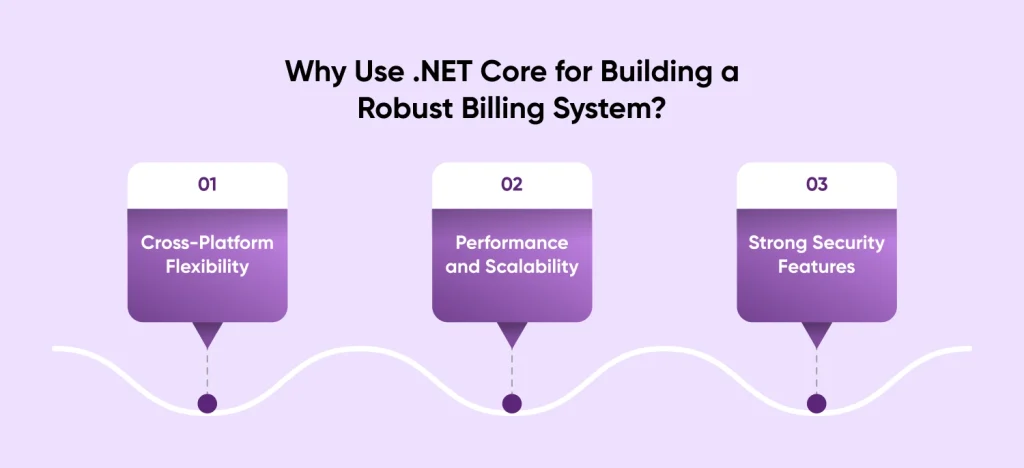In today’s digital commerce landscape, managing tax compliances across different jurisdictions poses a significant challenge for businesses. When building a .NET Core billing system, implementing an automated tax calculation process is not just convenient, it’s a requirement in today’s time to stay compliant with changing regulations.
This blog will discuss how to integrate Avalara – a leading tax automation platform, into your .NET Core applications for creating a scalable, efficient and compliant billing system, customized to your business processes entirely.
Why Use .NET Core for Building a Robust Billing System?

When it comes to developing sophisticated software solutions with complex requirements and large volume data handling, .NET Core emerges as a strategic choice that offers many benefits for building a robust billing system:
Cross-Platform Flexibility
.NET Core is popular for building cross-platform app solutions that work on Windows, MacOS, Linux and multiple environments. This allows the billing system to work smoothly on any platform; from on-premise to any cloud provider.
Performance and Scalability
Billing systems need to process high-volume and rapid transactions, especially during business hours or season. .NET Core has a robust architecture that enables faster request processing, efficient memory management, and horizontal scaling. All these features are ideal for building a .NET Core billing system that requires real-time tax calculation and avoiding delays in the checkout process.
Strong Security Features
When handling financial transactions and tax calculations, security cannot be compromised. .NET Core provides excellent security features such as data protection APIs for securing sensitive information, identifying framework for authentication and authorization and more.
Why Use Avalara for Tax Automation in .NET Core?
Avalara is a credible and most-used cloud-based tax compliance platform. It automates the complex process of calculating, collecting and remitting sales tax. For businesses that work in multiple states or countries, keeping track of the diverse tax regulations and ensuring compliance with them, can be a tiresome and difficult job. Avalara provides the tax automation needed to build a robust billing system.
When building a .NET Core billing system with Avalara, you get benefits such as:
- Real-time tax calculation based on precise geolocation
- Automatic updates to tax rates and rules across all jurisdictions
- Reduced audit risk through improved compliance accuracy
- Simplified tax reporting and filing processes
- Scalability that grows with your business operations
The .NET Core framework is great for the foundation of enterprise-grade billing systems. It provides smooth integration with Avalara. Its performance capabilities and a tight-knit ecosystem makes it ideal for building a tax-compliant billing system that can handle high transaction volumes with precision.
Challenges in Tax Compliance and How Avalara Solves Them
Handling tax compliance is highly complicated, and it is very important to maintain accuracy in handling them. Incorrect tax compliance can result in costly errors, penalties and increase administrative overhead. It is important to understand these challenges when building a .NET Core billing system, and how Avalara solves them:
| Challenge | Description | Avalara Solution |
| Regulatory Changes | Over 13,000 US tax jurisdictions with frequently changing rates and rules. | Real-time updates to tax rates and rules without manual intervention. |
| Tax Nexus Determination | Complex economic nexus requirements following South Dakota v. Wayfair. | Identifies where your business has tax obligations based on transaction patterns. |
| Product Taxability | Different products taxed differently across jurisdictions. | Standardized tax codes with built-in product category rules. |
| Address Validation | Incorrect addresses lead to wrong jurisdiction assignment. | Precise address validation and jurisdiction identification. |
| Exemption Management | Tracking and validating tax exemption certificates. | Digital certificate collection, storage, and validation. |
| Cross-Border Commerce | International sales with VAT, GST, and customs duties. | Global tax calculation for cross-border transactions. |
| Audit Preparation | Detailed documentation requirements during audits. | Comprehensive audit trail of all tax decisions and calculations. |
Step-by-Step: Avalara Integration with .NET Core
Prerequisites
- Avalara Developer Account: https://developer.avalara.com/
- AvaTax Authentication info: Base URL, Account Number, License Key
- Technology: .NET Core 3.1 or .NET 5/6/7+
- IDE: Visual Studio / VS Code
- NuGet Package: Avalara.AvaTax.RestClient
Step 1: Create a Project with Web API and ASP.NET Core
dotnet new webapi -n AvalaraIntegration
cd AvalaraIntegrationThis command prompt helps build Web API with ASP.NET Core with the name “AvalaraIntegration”. We use the “cd” command to change the directory to a newly created project folder, so all the work for this project can be handled within it.
Step 2: Install Avalara NuGet Package
dotnet add package Avalara.AvaTax.RestClientInstall this NuGet package to get access to the necessary classes and methods required to interact with Avalara’s AvaTax API. This package simplifies the process of making API calls and handling responses.
Step 3: Configure Avalara Settings in appsettings.json
"Avalara": { "AccountNumber": "YOUR_ACCOUNT_NUMBER", "LicenseKey": "YOUR_LICENSE_KEY", "Environment": "sandbox", // or "production" "CompanyCode": "YOUR_COMPANY_CODE"
}In this step, you define the configuration settings for Avalara in the appsettings.json file. This includes your account credentials and environment settings. The Environment can be set to either sandbox for testing or production for live transactions. Replace the placeholders with your actual Avalara account details.

Step 4: Create AvalaraSettings.cs
public class AvalaraSettings
{ public string AccountNumber { get; set; } public string LicenseKey { get; set; } public string Environment { get; set; } public string CompanyCode { get; set; }
}This class is added as a model for holding the Avalara configuration settings. Create a strongly typed class and get access to all Avalara settings anywhere on your .NET Core application.
Step 5: Register Settings in Program.cs or Startup.cs
builder.Services.Configure<AvalaraSettings>( builder.Configuration.GetSection("Avalara"));This line registers the AvalaraSettings class with the dependency injection (DI) container. It binds the configuration section from appsettings.json to the AvalaraSettings class, making it available for injection into other classes.
Step 6: Create Avalara TaxService
using Avalara.AvaTax.RestClient;
using Microsoft.Extensions.Options;
public interface IAvalaraTaxService
{ Task<decimal> CalculateTaxAsync(string customerCode, string postalCode, decimal amount);
}
public class AvalaraTaxService : IAvalaraTaxService
{ private readonly AvalaraSettings _settings; private readonly AvaTaxClient _client; public AvalaraTaxService(IOptions<AvalaraSettings> settings) { _settings = settings.Value; _client = new AvaTaxClient("MyApp", "1.0", Environment.MachineName, _settings.Environment == "sandbox" ? AvaTaxEnvironment.Sandbox : AvaTaxEnvironment.Production) .WithSecurity(_settings.AccountNumber, _settings.LicenseKey); } public async Task<decimal> CalculateTaxAsync(string customerCode, string postalCode, decimal amount) { var taxRequest = new CreateTransactionModel { type = DocumentType.SalesOrder, companyCode = _settings.CompanyCode, date = DateTime.UtcNow, customerCode = customerCode, addresses = new AddressesModel { singleLocation = new AddressLocationInfo { postalCode = postalCode } }, lines = new List<LineItemModel> { new LineItemModel { number = "1", quantity = 1, amount = amount } } }; var taxResult = await _client.CreateTransactionAsync(null, taxRequest); return taxResult.totalTax ?? 0; }
}- Service Interface: The IAvalaraTaxService interface provides a contract for the tax calculation service. This ensures any implementation provides a method to calculate tax asynchronously.
- Service Implementation: The AvalaraTaxService class implements the IAvalaraTaxService interface. It uses a client to communicate with Avalara’s API.
- Constructor: The constructor initializes the AvaTaxClient with the application name, version, machine name, and environment (sandbox or production). It also sets up security using the provided account number and license key.
- CalculateTaxAsync Method: This method builds a tax request using the CreateTransactionModel, which includes transaction details such as type, company code, customer code, and line items. It then calls the Avalara API to create a transaction and returns the total tax amount.
Step 7: Register AvalaraTaxService in DI Container
Register the AvalaraTaxService using dependency injection container as a scoped service. It creates a new instance of AvalaraTaxService for each HTTP request, to ensure that the service is thread-safe and can maintain state during the request lifecycle.
builder.Services.AddScoped<IAvalaraTaxService, AvalaraTaxService>();Step 8: Create a TaxController
[ApiController]
[Route("api/[controller]")]
public class TaxController : ControllerBase
{ private readonly IAvalaraTaxService _taxService; public TaxController(IAvalaraTaxService taxService) { _taxService = taxService; } [HttpGet("calculate")] public async Task<IActionResult> CalculateTax(string customerCode, string postalCode, decimal amount) { var tax = await _taxService.CalculateTaxAsync(customerCode, postalCode, amount); return Ok(new { TaxAmount = tax }); }
}- Controller Definition: The TaxController class is decorated with [ApiController], which enables automatic model validation and other API-specific behaviors.
- Dependency Injection: The constructor takes an instance of IAvalaraTaxService, allowing the controller to use the tax calculation service.
CalculateTax Method: This HTTP GET method accepts parameters for customer code, postal code, and amount. It calls the CalculateTaxAsync method of the tax service and returns the calculated tax amount in the response. The use of IActionResult allows for flexible response types, including success and error responses.
Avalara API example for developers
This is an example of how to call the CalculateTax endpoint. You can replace the query parameters with actual values to test the tax calculation. The API will return a JSON response containing the calculated tax amount based on the provided parameters.
Testing Checklist
- Validate account credentials
- Test with different ZIP codes
- Try different amounts and items
- Verify tax result matches expected state tax
Get professional ASP.NET Core development services to make sure they can configure .NET and Avalara in the most optimal way possible to match your project needs without adding unnecessary features or overcomplicating the process.
Best Practices for Avalara Integration in .NET Core
Here is a list of best practices for Avalara integration your development team should follow when integrating Avalara with .NET Core:
- Prevent failures by calling tax API after validation addresses.
- Use service layer and DI for Avalara calls.
- Reduce API calls with proper tax code and static data caching.
- Follow Best Practices for .NET Core Development such as using async/await and clean architecture.
When to Hire ASP.NET Core Developer for Avalara Integration?
For teams that want to build a web store or subscription billing system and automate tax compliance with Avalara and .NET, across the US or for international markets, they can hire ASP.NET Core developers with experience in Avalara API integration, sales tax logic and REST API connectivity. We have proven experience in building tax-compliant solutions.
Expert Avalara Integration
We can integrate Avalara’s powerful API into your existing system, enabling seamless tax calculations, rate updates, and compliance across regions.
Custom Tax Logic Implementation
At CMARIX, our developers tailor sales tax logic to your specific business needs, ensuring tax rates are calculated accurately for different locations, products, or customers.
Scalability and Speed
We build a web store with .NET Core that can scale operations and performance needs to handle high transaction volumes without compromising on performance.
Continuous Compliance and Security
With CMARIX, you get a solution that’s always up-to-date with changing tax laws and protected by the latest security standards, safeguarding your business and customers.
Final Words
Integrating Avalara with the .NET Core billing system is a great way to handle tax compliance complications. It streamlines complex calculations and improves invoicing accuracy. Make sure to opt for reliable ASP.NET Core development services to get a team of experienced .NET developers that have experience in delivering such billing systems.
FAQs on Building a .NET Core Billing System with Avalara
What is Avalara and why integrate it with a .NET Core billing system?
Avalara is a cloud-based tax compliance platform that connects smoothly with the .NET Core billing system. Combining the two gives real-time tax calculation, reduces compliance risks and eliminates the need for manual tax management. If you want to build a web store with .NET Core, contact our sales team.
Which language is used for billing software?
C# uses strong typing and object-oriented features. When it is combined with .NET Core for cross-platform benefit, C# becomes an ideal base for developing robust, secure and scalable billing systems.
How to integrate Avalara in .NET Core?
Integrating Avalara in .NET Core requires creating a service class that talks with Avalara’s REST API. We can use the RestSharp package for integrating it with Avalara. Configure the Avalara credentials in appsettings.json, building request models that match Avalara’s API schema and creating controller endpoints for calling the Avalara service needed for tax calculation before completing transactions.
What are common challenges when integrating Avalara with .NET Core?
Common challenges include handling address validation errors, managing API rate limits, properly mapping product tax codes, implementing error handling for failed API calls, caching responses for performance, and testing across different tax jurisdictions. These challenges can be mitigated through proper error handling, caching strategies, and comprehensive testing.







